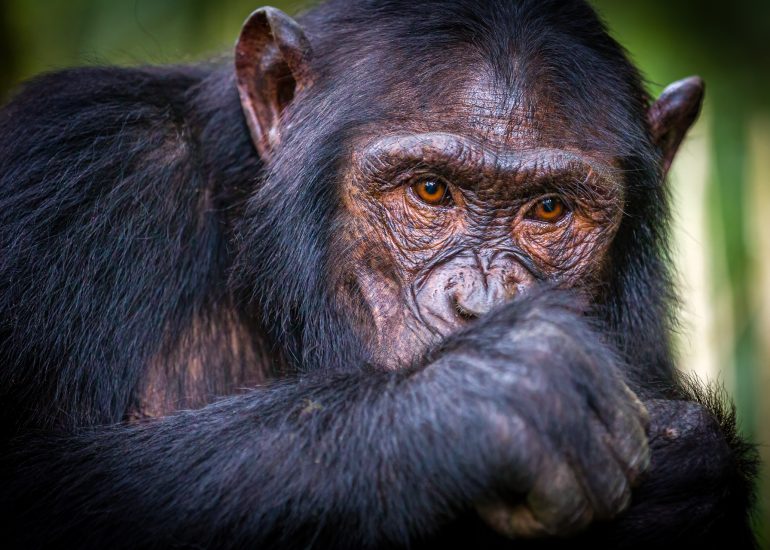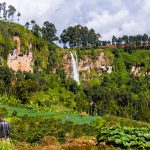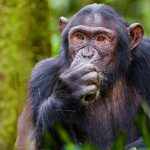Uganda
Journal
The Pearl Of Africa
Part 3
Day 5
Lira – Murchison Falls Nationalpark
The drive from Lira to Murchison Falls National Park takes us through the beautiful Ugandan countryside. The distance we have to cover today is about 200 km and we expect to drive for at least 4 – 5 hours. As we leave Lira, we pass through small towns and villages, where we can catch again a glimpse of local life and culture. The road is generally in good condition, but there may be some rough patches, so it’s advisable to have a 4WD vehicle.
After driving for a few hours, we decide to take a break and enjoy a coffee. There are cozy little coffee shops along the way serve up delicious coffee, tea, and snacks in a relaxed and friendly atmosphere. It’s perfect to take a break, stretch the legs, and recharge before continuing the journey.
The landscape become more rugged as we get closer to Murchison Falls National Park. You’ll pass by fields of crops and traditional homes before entering the park itself. The park is home to a wide range of wildlife, including elephants, lions, giraffes, and many others. It’s a fantastic opportunity to see some of Africa’s most magnificent creatures up close.
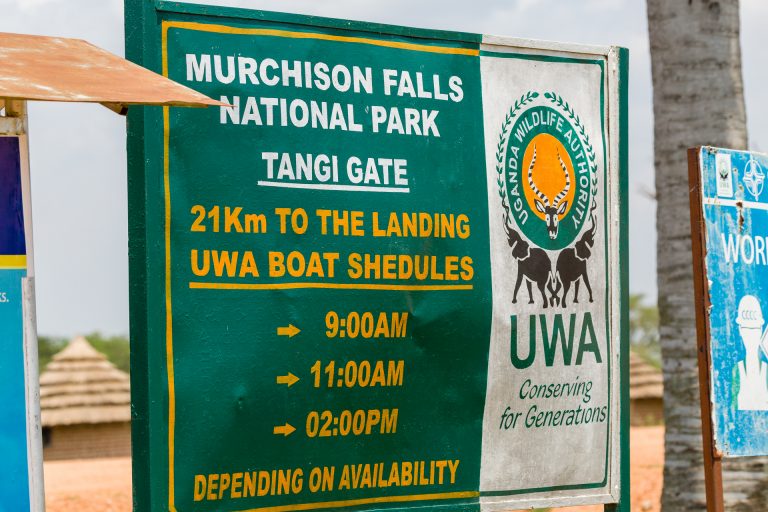
Nationalpark Entry
Inside the Park – Pakuba Safari Lodge
Murchison Falls National Park is one of Uganda’s most popular and breathtaking tourist destinations. Located in the northern part of the country, the park covers an area of over 3,840 square kilometers and is named after the magnificent Murchison Falls, which is the highlight of the park.
We stay at the Pakuba Safari Lodge. The Pakuba Safari Lodge is a very nice accommodation option located in the heart of the National Park. The lodge is nestled in a serene location, surrounded by vast plains and natural beauty, making it the perfect place to relax and unwind while immersing oneself in the natural wonders of the park. One of the standout features is its breathtaking views of the Nile River. The lodge overlooks the river, providing guests with stunning panoramic views of the park and its wildlife. This makes it an ideal spot to watch the sunset or simply enjoy a cup of coffee in the morning while taking in the serene surroundings.
The lodge itself is also a sight to behold. It features beautifully designed rooms that are spacious, comfortable, and well-appointed with modern amenities to ensure a comfortable stay. The rooms are tastefully decorated with traditional African art and furniture, giving guests a sense of place and a cultural experience. From the warm reception to the delicious meals served, everything is done to exceed guests‘ expectations and ensure their comfort.
Beside all this, the special feature is that there are not fences. Animals are coming to the lodge and you can spot warthogs and antelopes. Also some agamas are all around.
Wildlife and Game Drive
The park is home to a wide range of wildlife, including elephants, lions, leopards, giraffes, buffaloes, hippos, and crocodiles. The park is also a bird-watcher’s paradise, with over 450 species of birds recorded. Visitors can go on game drives to see the wildlife up close. The park has a well-maintained road network, making it easy to explore the vast plains and forests in search of animals.
Game Drive
If you are engaged in a safari for the first time or generally with a trip to an African country to observe animals, you inevitably come across the term „Game Drive“. To explain it simply, the Game Drive describes the activity that you probably do most often during a safari. You drive with a usually open vehicle 4 x 4 through the bush or the savannah and look for wild animals (game) that you want to observe.
In the sense meant here means the word „game“ is the name for the wild animals. In addition to a game drive, you can also do game walks. That is then equivalent to a walking safari. In this case, you walk through the wilderness and look for the animals on foot. Of course, this should happen in the company of an experienced ranger.
You can often book guided game drives in the accommodations. Then a guide or a ranger drives with you. That has a big advantage. The guides and the rangers are networked with each other and often also on tour together and can thus inform each other about special sightings at any time. In addition, through experience, there is often a high probability that you will see rare animals. Often rangers and or guides know pretty much exactly where the animals stayed, e.g. the day before. This then offers a good starting point.
The other variant is self-driving. Here you also have the challenge of finding the animals yourself. In my opinion, this is often more exciting when you have found the leopard or the lion alone. It is simply a great experience. So both variants have their advantages.
When is the best time to do a game drive?
Usually the Morning Game Drive takes place before breakfast. It is the best opportunity to find predators with their prey. In addition, the animals are generally more active at this time, as it is not so warm yet. You should dress warmly for the morning game drives. The same applies to night drives. The second game drive is started in the late afternoon when the midday heat is over.
Due to the two selected times, you usually also have good flat incident light for photographing, as the sun either rises straight or has slowly taken up an animal-standing position again.
For every Game Drive, you should stay in the car, especially if you are traveling alone. This is the safest place. Otherwise, one more thing is essential for a great game drive – your attitude. Be grateful for what nature offers you. There is no guarantee for lions or leopards. But believe me, there is nothing better than seeing wild animals in their natural environment
Day 6
Boat trip to the Murchison Falls
This is the main attraction of the park, and it’s easy to see why. The Nile River, which runs through the park, squeezes through a narrow gorge and plunges 43 meters, creating a thunderous roar and a beautiful spray of water. Visitors can take a boat ride to the bottom of the falls or hike to the top for stunning views.
A boat trip to the Murchison Falls on the Nile River can be a thrilling and memorable experience, however if it’s accompanied by heavy rain and storm, it can also be quite challenging.
As the journey begins, the boat slowly moves along the Nile River, surrounded by lush green vegetation and accompanied by some Hippos which rest close to the shore. We reach the falls and we could observe that the weather started to change.
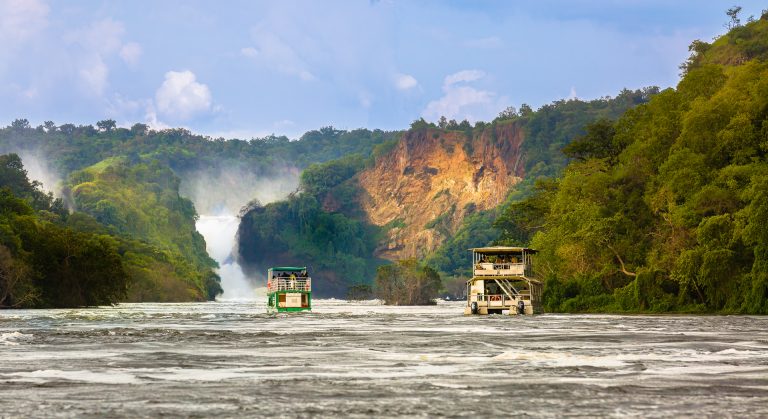
Boat Trip to the Murchison Falls
As the rain starts to pour down, the boat begins to sway back and forth, making it difficult to navigate through the river. The crew quickly springs into action, trying to keep the boat steady and on course. But the storm intensifies, with strong winds and heavy rain lashing against the boat. The crew struggles to keep the boat from capsizing as they fight against the turbulent waters. The passengers huddle together, trying to stay dry under whatever cover they can find, while holding on tightly to the sides of the boat. The sound of the falls is deafening and mixes with the wind and the rain. It is even a bit terrifying. The rain and the spray from the water is carried by the wind, soaking everyone on board.
As the boat turns back towards the shore after more than one hour, the storm begins to subside, and the passengers breathe a sigh of relief. They are tired and wet, but they feel a sense of accomplishment and pride for having braved the storm and made it to the Murchison Falls. The boat slowly makes its way back to the shore, as the passengers reflect on the incredible adventure they have just experienced.
After being dried by the sun again we go back to the Pakuba Lodge. Some lunch helps and after that we enjoy the peaceful surroundings of the lodge. In the afternoon we go for another game drive in the park. It seems that after the „perfect storm“ we are going to be rewarded by nature as we spot a real highlight in the park. The Grey Crowned Crane.
The Grey Crowned Crane is a bird species that is native to the African continent and is highly regarded as a symbol of beauty, grace, and cultural significance. In Uganda, the Grey Crowned Crane is a national symbol and appears on the country’s flag, coat of arms, and currency.It is a striking bird with a distinct grey and white plumage and a crown of golden feathers on its head. It is known for its elegant and graceful dance displays during courtship and its loud and distinctive calls. The bird is highly valued in Ugandan culture, where it is considered a symbol of prosperity, nobility, and beauty.
The Grey Crowned Crane has been a part of the Ugandan flag since the country gained independence in 1962. The bird is depicted in its natural habitat, standing on one leg with its wings outstretched, and is surrounded by six yellow stars that represent the country’s motto of „For God and My Country.“ The bird’s presence on the flag highlights Uganda’s commitment to environmental conservation and reflects the country’s natural beauty and cultural heritage.
The Grey Crowned Crane is an amazing dancer and a lucky charmer. People believe that they can bring the rain and include pictures of cranes in their rituals to encourage the raining season to come. They are seen as protectors of the well being for humans and their cattle. The majestic name is program with this bird. The graceful walking and the impression it gives when you see it for the first time might be one of the reasons for that. The mating ritual for instance is kind of a most elegant dance involving jumping and bowing. It is a sight to remember.
This amazing bird has a height of 1 to 1,10 meter and weighs between 3 and 4 kg. The wingspan is impressive with 180 up to 200 cm. The life span is between 22 and 25 years. The feathers are black with white wing tops and bottoms. A yellow/golden crown on top of the black capped head is characteristic for the bird and for a crane it has a very short bill. It is kind of elegant walking through the wetlands, savannas, open grassland and even in cultivated areas.
They are very active during the day while you can observe them in grassland and other areas e.g. cultivation, pecking to reach for food. It is observed that those birds are very territorial with regards to their nesting sites. Outside of the breading season they are often observed in flocks of 30 – 150 individuals. Once they have found a partner they stay together forever. They regularly tidy and clean their feathers to strengthen their bond and they also perform dances. Especially in the breading season they perform dancing, bowing, running and jumping accompanied by booming calls.
The breading season varies with the rains and peaks from December to February. After the selection of the nest site the couple starts to build their nest together. In this time they get territorial. Often you can find the nest close to the edge of the wetland. They lay 1 – 4 eggs and incubate them together for 50 – 60 days.
Grey crowned cranes move locally and seasonally according to food sources, availability of nesting sites and the rains. They are omnivores and eat plant like fresh grasses, seeds of sedges as well as insects, worms, lizards, frogs and even crabs. They also show an interesting behavior while looking for the food. They stomp on the ground to transitive their bait and as soon the bait moves they pick it up.
Unfortunately the Grey Crowned Crane belongs to the endangered species of birds. Especially the destruction of wetlands and the pollution of their habitats by agrochemicals and industry are part of the threat.
We spot also many other bird. Amongst them some kingfishers, the saddle billed stork and we also see a lot of Giraffes during our expedition. That was an exiting day and with a lot impressions we go to bed. Tomorrow a hike at the falls is waiting for us.
Day 7
Hike to the falls
A hike to the Murchison Falls waterfall is a truly awe-inspiring experience that will leave visitors with lasting memories of their trip to Uganda. The hike takes visitors through the heart of Murchison Falls National Park, offering breathtaking views of the Nile River and the surrounding landscape. With our yesterday’s experience and still some mixed feelings we drive to the top of the falls.
Here the hike begins, where visitors can take in the incredible sight of the Nile River rushing towards the edge of the cliff before plummeting down to create a magnificent waterfall. And from here, we begin our descent down a steep and winding trail that takes us to the base of the falls.
Along the way, we are able to enjoy stunning views of the falls and the surrounding area. The trail winds through lush forests, rocky outcroppings, and open plains, providing a varied and exciting hiking experience. You can expect to encounter a variety of wildlife, including baboons, monkeys, and a variety of bird species.
At the base of the falls, one can feel the power of the water as it crashes down and creates a misty spray that refreshes and invigorates.
The hike to the Murchison Falls waterfall is a rewarding experience that offers visitors an up-close and personal encounter with one of the most magnificent waterfalls in the world. It’s a journey that is sure to leave visitors with a sense of awe and wonder at the natural beauty of Uganda.
In the afternoon we do our last Game Drive in the Park before we call it a day and together with Innocent we enjoy the last evening at the Pakuba Safari Lodge with a nice beer and a good dinner.
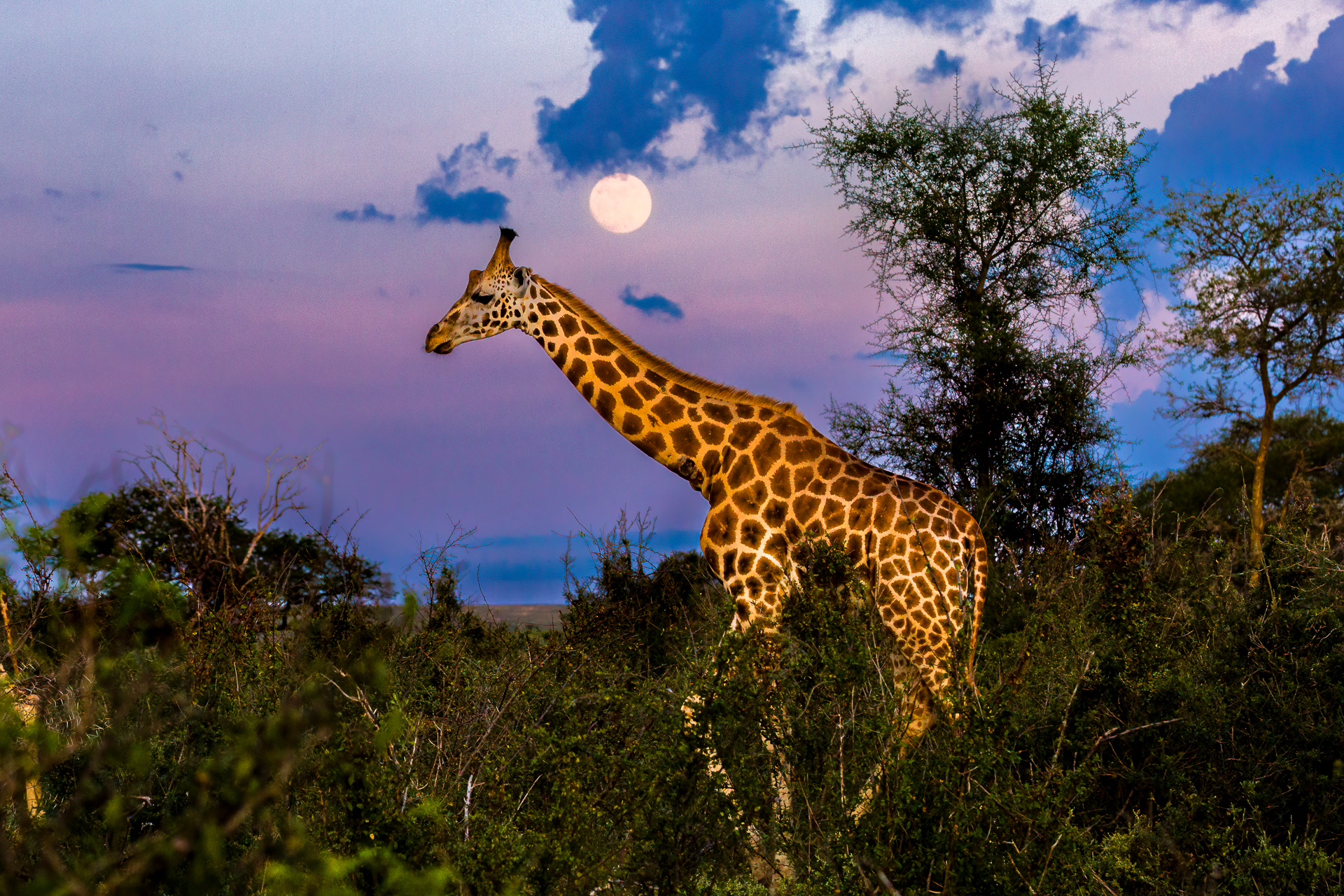
Portfolio
Uganda
"Africa has her mysteries, and even a wise man cannot understand them. But a wise man respects them" — Miriam Makeba
Birds Uganda
“Some birds are not meant to be caged, that's all. Their feathers are too bright, their songs too sweet and wild. So you let them go, or when you open the cage to feed them they somehow fly out past you. And the part of you that knows it was wrong to imprison them in the first place rejoices, but still, the place where you live is that much more drab and empty for their departure.” ― Stephen King, Rita Hayworth and Shawshank Redemption
Wildlife Uganda
“The more you learn about the dignity of the gorilla, the more you want to avoid people.” - Diane Fossey



